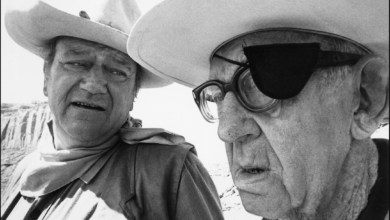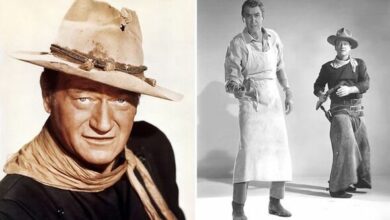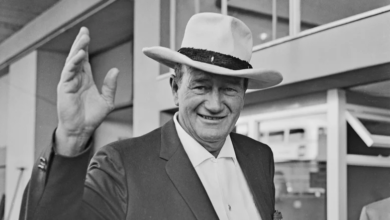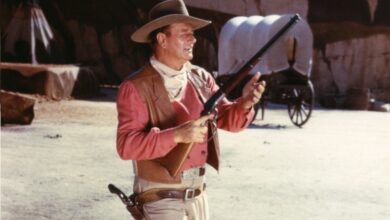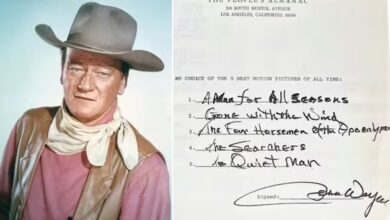Patrick Wayne said he learned how to be a movie actor from watching his father’s example
Patrick Wayne never really retired from acting. If the telephone rang and the right role came along, he would gladly get back in front of the cameras agin.
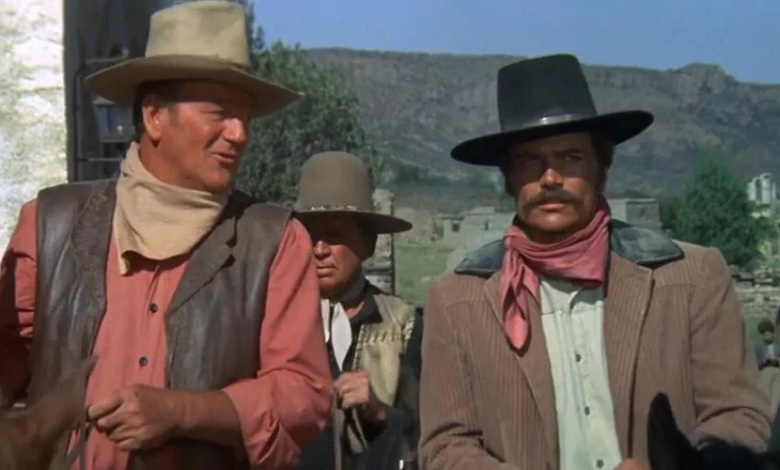
But the 83 year-old son of screen legend John Wayne has been more focused on raising money for the cancer center which bears his father’s name and keeping his legacy alive.
“I have never considered myself done with acting,” Wayne said in a telephone interview. “Although in this century, for the last 23 years, I have been very involved with cancer research. It’s been a rewarding ride. But if the call came and they had an interesting role they wanted me to play, I probably would do it.”
Wayne, who appeared in more than 40 films – 11 with his famous father – and on dozens of television, will be a guest at the MidSouth Nostalgia Festival being held June 8-10 in Olive Branch at Whispering Woods.
“It’s a great festival,” Wayne said. “A lot of people come each year and they say such nice things about my dad, which is always nice to hear.”
Wayne attends two or three festivals a year and the money he charges for autographs is donated to the John Wayne Cancer Foundation which helps fund fellowship programs to train cancer surgeons.
“I usually raise about $10,000 from these shows,” Wayne said. “It’s a very good return for a good cause for a couple of hours of work.”
Wayne was recently in Fort Worth at the Stockyards on May 26 with other family members to celebrate the 116th birthday of his father. The Stockyards is home to John Wayne: An American Experience, a 10,000 square foot exhibit featuring over 400 pieces of memorabilia on the life of John Wayne.
Wayne said the exhibit has been extremely well received.
“My brother Ethan really put together a comprehensive look at our dad’s film life and private life and public life,” Wayne said. “It has all of that going on there. I was really pleased with how well it turned out. We had 55,000 paid admissions the very first year. That’s pretty amazing. They had a lease for three years on the building site. They have extended that to 10 years. So it’s going to be there for a while. Texas is such a perfect place for a John Wayne exhibit. They love him down there.”
Wayne’s father starred in 179 movies and was one of the biggest box-office stars of his era in westerns such as “Stagecoach,” “The Searchers,” “The Man Who Shot Liberty Valance,” “The Shootist,” and “True Grit,” which won him an Academy Award as best actor. Wayne was also a symbol of American patriotism appearing in numerous war films like “Sands of Iwo Jima” and “The Green Berets.”
Over 40 years after his death, John Wayne was ranked 4th in a Harris Poll of “America’s Favorite Make Stars.” Wayne said he believes his father remains popular because he represented traditional core American values like love of one’s country, love of family, and faith in God, and that his movies were wholesome family entertainment.
“It’s our goal to keep the core values that he stood for alive,” Wayne said. “We so often today see people who are not treated with respect or decency in public and in politics. It’s a crying shame. It would be nice if people got back to being decent again.”
Wayne said it angers him when groups of people attack his father’s image and name by trying to portray him as a racist, homophobic, sexist, or a draft dodger for having never served in the military. There have even been attempts to take his father’s name off the airport in Orange County where John Wayne lived for decades.
Wayne said most of the criticism of his father comes from an interview he did with “Playboy Magazine” in 1971 that has been taken out of context.
“It seems like every generation a group will come up and take a swipe at him,” Wayne said. “It’s so wrong to judge people by today’s standards or whatever, and you don’t know what the pulse of the country was like. My father was the farthest thing from being a racist. A lot of these people take quotes from an article he did for “Playboy magazine.” It was a seven hour interview that they condensed down. It’s the job these magazines to sensationalize. So it comes off as something different.”
Wayne said his father tried to join the war effort, but the studio and federal government felt he was more valuable at home boosting morale by making movies. John Wayne was 34 at the time World War II broke out, well above the draft age and had four children to support.
He said there was probably no other actor who was more patriotic and supported the troops than his father.
“It’s pretty ridiculous,” Wayne said. “And he died more times on screen for his country than anybody else.”
Wayne said he got into acting to spend more time with his father.
He made his screen debut in an uncredited role in “Rio Grande” in 1950.
“I would go and visit my father on location,” Wayne said. “My brothers and sisters – there were four of us at the time – the other three siblings had no interest in acting at all. On one film, the director said how would you like to be in the movie? I said well, what does that involve? He said ‘well you get paid for it.’ Being nine years old and getting a salary was pretty cool. So any opportunity I had to go and work on a film with my dad I took because I had him all to myself. I didn’t have to compete with my brothers and sisters for attention. So it worked out pretty well.”
Wayne said his father didn’t give him any advice when he got into acting. He learned a lot just by watching the example that his father set when he was making a movie.
“He wasn’t a person to give advice,” Wayne said. “Most of the things I learned from him were by example. He was always on time. He was always prepared. It didn’t matter what happened the night before. If he was out until 3 a.m., he still showed up at 6 a.m. if that was his call and he was ready to roll. ”
Wayne said there was one time during the filming of “The Comancheros” where he has a close up of him riding a horse that drew his father’s wrath down on him because he didn’t feel he was physically prepared for what the scene called for.
“They looked at the dailies and I was just terrible,” Wayne said. “I was bouncing all over the place. My dad said ‘you’re going to learn to ride horses or you’re not going to be in this business.’ He put his foot down. I was embarrassed and humiliated. So for the next six weeks, every chance I got, I learned how to ride. They reshot the scene and it turned out well. But it was a very valuable lesson to learn.”
He became the pet of legendary director John Ford, a frequent collaborator on some his father’s greatest movies, who was also a close friend of the family. Wayne said John Ford was notorious for singling out individual actors or members of the crew and picking on them mercilessly.
Ford was his Godfather and never turned his ire on him.
“He found a reason to pick on every single person, both actors and the crew,” Wayne said. “But he never picked on me. I was his favorite. But guess what? I would go to work every day thinking, is this going to be the day? So I went through that toxic stress thinking it would be my turn over the barrel. But I adored him and respected him. I was just in awe of his skills as both a director and cinematographer. Nobody films more beautifully.”
He got his first screen kiss from Maureen O’Hara in Ford’s film “The Long Grey Line.”
“It was a scene at a train station as I was departing for World War I,” Wayne said. “She grabbed me and planted one on me. I was not even prepared for that. But I can still remember those luscious lips.”
Wayne recalled one scene in “The Searchers” where he plays a young cavalry lieutenant who reports to Rev. Capt. Samuel Johnson Clayton, played by Ward Bond, and said he could barely get his lines in because the notoriously gruff Bond kept interrupting him.
“Im trying to deliver my dialogue and they are all ad libbing,” Wayne said. “It was nothing that was in the script. And Ford was just letting it roll. I had to fight my way through it. It was a baptism and right of passage.”
Many of the actors who worked with Ford and his father like Bond, Victor McLaglen, Maureen O’Hara, Andy Devine, Ben Johnson, and Harry Carey, Jr. were like a close family.
“John Ford and my father had a group of people that he worked with more than once,” Wayne said. “They were like family. My dad was never into the Hollywood party scene, but he did know everybody. He kept a pretty close knit group of friends.”
Wayne said “Big Jake “ is his favorite move that he appeared in with his dad.
“He was just great in it,” Wayne said. “My brother Michael produced it and my father half directed it. It was a real family affair. And Richard Boone was so great. I had worked with him before that. I did an episode of “Have Gun Will Travel.” He was also in “The Alamo.”
Wayne’s own acting career reached its height in the 1970s following “Big Jake” when he appeared in the popular fantasy swashbuckler “Sinbad and the Eye of the Tiger” in 1976 with Jayne Seymour, and the adventure fantasy film “The People That Time Forgot” in 1977. He was even considered for the role of “Superman.”
Wayne said one of the great lessons he learned from his father – about being physically prepared to do a scene – served him well during the making of “Sinbad.” He didn’t know how to sword fight and spent a week rehearsing with a skilled stuntman. Producers came out to California, put a beard on him, and he performed the routine he had worked on with the stuntman for the screen test, which got him the role.
Wayne said the film’s producer, Charles Schneer, told him to be on location in Spain in six weeks. He told Schneer that he wanted to stay in California and continue working with the stuntman in order to learn the sword fighting scenes.
“I said, I don’t know anything about sword fighting. I would really like to work with this guy during this period,” Wayne said. “Schneer said ‘well, we have a guy who will work with you when you get over there.’ But I held my ground. I was’t going to go over there unprepared.”
Wayne practiced sword fighting and when it came time to film the most difficult and complex fighting scene in the movie, the stuntman Schneer said would be helping him wasn’t around.
“So we get on the set in the morning, they tell us to go work out the routine,” Wayne said. “They went away someplace and an hour later they came back and we told them we are ready to show them the routine. We showed them what we had choreographed and I hit all my marks.”
Wayne said he was lucky that he stayed in California for those six weeks and learned to sword fight or else the movie would have been ruined.
“The stuntman who was supposed to help me didn’t join us until we got to Malta,” Wayne said. “I can guarantee we would still be shooting in Spain if I hadn’t done this extra work learning how to sword fight. Charles Scanner came up to me afterward and said ‘that was a great idea I had of you working with that stuntman.’ If you want to take credit for it, that’s fine. But it was just an example of the importance of being prepared. Thats the biggest lesson I learned from my dad.”
“Sinbad and the Eye of the Tiger” featured special effects by stop motion genius Ray Harryhausen.
“He used these small models. And honestly, when I saw the film, I thought they were really there – and of course when we filmed it, they weren’t,” Wayne said. “You would film your scene with very strict blocking because he knew where he was going to put the skeletons and all that stuff. It was highly technical, but a very creative experience.’
Wayne said “Sinbad” was a very enjoyable movie to make.
“I got to be with Jane Seymour. And they paid me,” Wayne joked. “How much better can you get?”
He sat in on a screening of the movie and did a Q&A session when he was in Fort Worth for this father’s birthday celebration. It was the first time he had seen the movie since it came out in 1976.
“I couldn’t believe how young I was,” Wayne said. “It still looked pretty good. The action isn’t CGI, but it still holds up.”
Wayne stayed busy in the 1970s and 1980s on television guest starring on shows like “Fantasy Island,” “The Love Boat,” “Murder, She Wrote,” “Sledge Hammer,” and “MacGyver.” He also appeared as Pat Garrett in the 1988 western “Young Guns” and in other big screen projects “Rustler’s Rhapsody,” “Chill Factor” and “Her Alibi.”
He also did a stint as a game show host on “The Monte Carlo Show” and “Tic-Tac-Dough.”
“I loved the game shows,” Wayne said. “I’m sorry it wasn’t more successful, but it was so much fun.”
Wayne recalled an episode on “Tic-Tac-Dough” when the producers came up with the idea of having divorced couples appear as contestants, which led to one particularly hilarious moment.
“They didn’t test them for general knowledge like everybody else who came on the show,” Wayne said. “They had multiple choice answers to choose from. They said so many crazy things. One question was, this is the story of a young girl who wrote a diary who was hidden in an attic in Amsterdam. The choices were, is it Sylvia Plath, Anne Frank, or Eva Braun? And the husband says ‘Eva Braun.’ I was stunned. And the audience almost as one said “Eva Braun?!?!?!” They couldn’t believe it. But that’s what happens on a game show.”
Wayne said while his children are busy with their own lives and careers, they remain involved in raising money for cancer research and understand the importance of preserving John Wayne’s legacy.
“We all work to raise money for the foundation,” Wayne said. “They are very supportive of that. They’re all in different walks life, but they have all been around. I took them around on location when they were children. So they are all well-versed in this stuff, but didn’t choose to go that way. My oldest son, he is the chairman of a committee at St. John’s Health Center. We have a cancer research institute and they have a big hunk of money that they give to the committees. So he is doing that work. The grandkids are busy making their own careers, but I am hopeful they will get involved as well. But it is still alive.”
Wayne said he is very grateful to the many fans who still love and are watching his father’s movies.
“Especially when they come to these nostalgia conventions,” Wayne said. “It is great to hear it and see the fans.”

